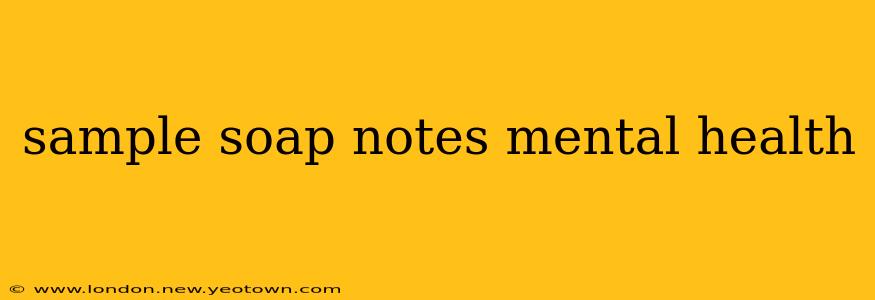Sample SOAP Notes for Mental Health: A Closer Look at Different Scenarios
This article provides sample SOAP notes for mental health professionals. Remember, these are examples and should be adapted to reflect the specific client, their presenting issues, and the professional's clinical judgment. Using accurate and detailed documentation is crucial for legal and ethical reasons. Never use these examples verbatim.
Understanding the SOAP Note Structure:
Before diving into the examples, let's briefly review the SOAP note format:
- S (Subjective): What the patient tells you. This includes their chief complaint, history of present illness, and any relevant personal or social history information. Use direct quotes when possible.
- O (Objective): What you observe. This section includes measurable data like vital signs, mental status exam findings (MSE), and results of any tests.
- A (Assessment): Your professional interpretation of the subjective and objective data. This is where you diagnose and formulate a treatment plan. Use appropriate diagnostic codes (e.g., DSM-5 or ICD codes).
- P (Plan): Your plan of action. This details the treatment strategy, including medication, therapy, referrals, and follow-up appointments.
Sample SOAP Note 1: Initial Assessment for Depression
Patient: Jane Doe, 35-year-old female
Date: October 26, 2023
S: "I've been feeling down for the past three months. I've lost interest in things I used to enjoy, like spending time with my friends and even my hobbies. I'm sleeping a lot more than usual and I have no energy. I just feel hopeless." Reports decreased appetite and significant weight loss. Denies suicidal ideation.
O: Alert and oriented. Affect constricted. Mood depressed. Speech slowed. Eye contact minimal. MSE: Thought process linear, thought content consistent with depressed mood. Insight and judgment fair. No suicidal or homicidal ideation reported.
A: Major Depressive Disorder, Single Episode (DSM-5 296.20). Rule out other medical conditions contributing to symptoms.
P: Initiate psychotherapy (CBT). Prescribe Sertraline 50mg daily. Schedule follow-up appointment in one week. Educate patient on medication side effects and importance of adherence. Assess suicidal ideation at each visit.
Sample SOAP Note 2: Follow-up for Anxiety
Patient: John Smith, 28-year-old male
Date: November 15, 2023
S: "I'm still experiencing anxiety, but it's a little better than last week. The panic attacks are less frequent, maybe one every other day instead of daily. I've been using the relaxation techniques you taught me." Reports improved sleep.
O: Alert and oriented. Affect appropriate. Mood anxious, but less severe than previous visit. Speech fluent. Eye contact good. MSE: Thought process linear, thought content reveals some anxiety, but less intense than previously noted. Insight and judgment good.
A: Generalized Anxiety Disorder (DSM-5 300.02). Patient demonstrating good progress with therapy and medication.
P: Continue with weekly therapy sessions. Maintain current dosage of Alprazolam 0.5mg PRN for panic attacks. Continue relaxation techniques. Schedule follow-up appointment in two weeks. Discuss potential increase in therapy frequency if needed.
Sample SOAP Note 3: Crisis Intervention
Patient: Sarah Jones, 22-year-old female
Date: December 8, 2023
S: "I want to die. I can't take it anymore." Patient reports feeling overwhelmed by academic pressure and relationship difficulties. Reports having thoughts of self-harm.
O: Appearance disheveled. Affect flat. Mood severely depressed. Speech pressured. Eye contact poor. MSE: Thought process disorganized. Thought content reveals suicidal ideation and hopelessness. Insight and judgment poor.
A: Suicidal ideation with intent. Major Depressive Disorder (DSM-5 296.20). Requires immediate intervention.
P: Hospitalization recommended for safety and stabilization. Contact patient's family. Initiate crisis intervention. Arrange for immediate psychiatric evaluation.
Frequently Asked Questions (PAAs) Addressed Implicitly:
While not explicitly asked as PAA's, the above samples address many common questions implicitly:
- What information goes in a mental health SOAP note? The examples showcase the comprehensive nature of a mental health SOAP note, including subjective reports, objective observations (MSE), assessment (diagnosis), and the treatment plan.
- How do I write a mental health SOAP note for depression? Sample 1 demonstrates this.
- How do I write a mental health SOAP note for anxiety? Sample 2 illustrates this.
- What does a crisis intervention SOAP note look like? Sample 3 provides a crisis intervention example.
Disclaimer: This article is for educational purposes only. It is not intended to be a substitute for professional training in mental health. Always consult with your supervisor or other qualified professionals for guidance on proper documentation procedures. This information should not be used for diagnostic or treatment purposes.

